Videotape and magnetic tape
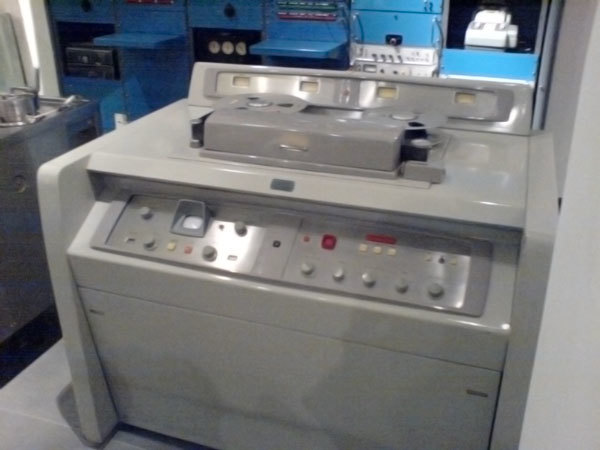 In 1898, Dane Waldemar Poulsen demonstrated a device for magnetic sound recording. At that time, phonographs of Thomas Edison's design already existed, in which tens of seconds of voice recording fit. To record sound on a phonograph, the needle applies a sound track on a replacement drum. From the same sound track with a needle they remove the sound.
In 1898, Dane Waldemar Poulsen demonstrated a device for magnetic sound recording. At that time, phonographs of Thomas Edison's design already existed, in which tens of seconds of voice recording fit. To record sound on a phonograph, the needle applies a sound track on a replacement drum. From the same sound track with a needle they remove the sound.Telegraph Poulsen looks similar: it also has a vertical drum, but from steel wire. An electric signal is applied to the recording head, the carrier moves at a constant speed near the head, and the magnetization corresponding to the signal remains on it. To play, you need a playback head, which passes and records changes in the magnetic field of the wire, and then converts them into an electrical signal. In 1900, the voice of the Emperor of Austria Franz Joseph I remained on the wire - today it is one of the oldest magnetic recordings that survived to our days. Subsequently, telegraphs were sold as speech recorders for everyday life, for entertainment, and as a voice recorder.
Of course, the device from the nineteenth century had its own characteristics. For example, the invention of the Pulssen signal amplifier was not, therefore, the sound needed to be heard in the headphones. The recording quality was only slightly higher than that of mechanical phonographs. But the principles of the functioning of the telegraph remained exactly the same as that of the devices is much more complicated than it. These devices have learned to record high quality sound, data, and even video. To do this, engineers had to solve more than a dozen problems.
First linear attempts
In 1928, Fritz Pfleimer invented a new type of carrier. On a long strip of paper, they applied iron oxide powder Fe 2 O 3 — this could hardly resemble a dark brown tape of audio cassettes. The magnetic tape gained its shape as a result of further work of the German electronics company AEG and the chemical giant BASF . Although all this happened before the Second World War, the novelty left Germany only as trophy samples. Before that, there was fragmentary information caused by the regime of secrecy.
')
The allies received German “magnetophones” and quickly improved audio recording technologies, added stereo sound capabilities and enhanced the overall quality of the technology. They guessed about the advantages of magnetic sound recording for a long time: German broadcasts, re-broadcast in recordings, were almost no different in quality from their original performances.

AEG Magnetophon Tonschreiber B from a German radio station, assembled after 1942.
Recording studios, which were still written on mechanical master discs before, quickly appreciated the advantages of the novelty. Twenty years, 1945 to 1965, the standard in the studios was the tape. The magnetic era has come. It was possible to record tracks longer than before, combine recordings of several different people. The magnetic tape made it possible to assemble the recording of each of the instruments in their best possible quality into a single form. The sound in the work appeared plasticity, which was available except in the installation of the movie.
On the tape tried to record and video. At that time, the film was the only video carrier. Even for television, the signal was written on film in special installations of film recorders . The devices, in fact, were a camera, a TV, and a special synchronization system for the hopping mechanism. Television signal recording was needed not even for distant descendants, but for retransmitting a television signal in other time zones. By 1954, the television industry consumed more tapes than all Hollywood studios.
It is logical to try to adapt the new rewritable media for video - in some ways it is quite similar to the audio signal. One difference hindered. The frequency band at the analog television signal is much wider than that of the sound - 5-6 MHz and higher versus 20 kilohertz distinguished by human sound.
If you put the tape on the usual audio recording speed and try to record a television signal, then nothing good will come out. The recording head creates a varying magnetic field, and dust particles are magnetized accordingly. The tape is pulled at a constant speed, then the next tiny strip of particles is magnetized. But if the magnetic field changes too quickly, then the particles will be magnetized in a random direction.
The bandwidth of a magnetic tape is related to speed: the higher the signal frequency, the higher the tape speed must be. That is, "in the forehead" the problem can be solved by skipping the tape faster. The first attempts to record a television signal on a magnetic tape worked in this direction.
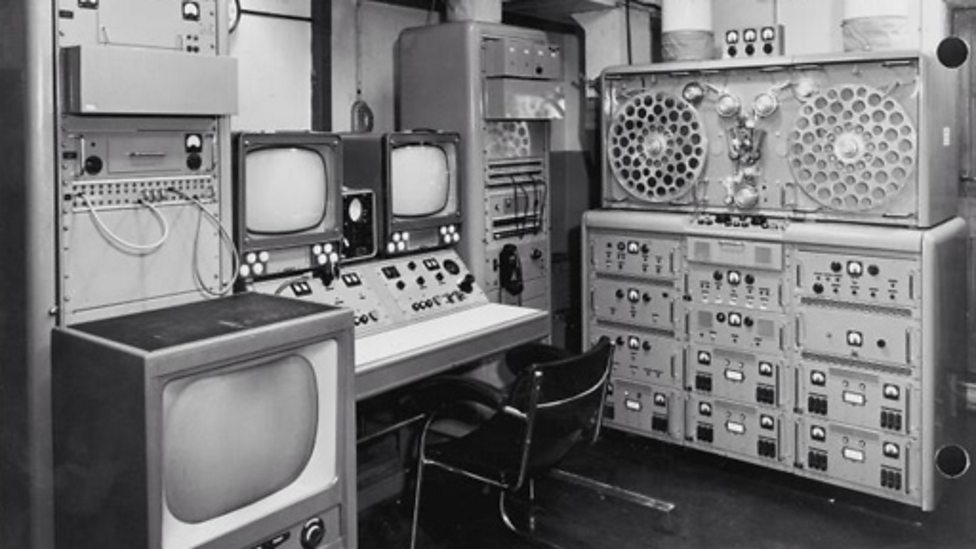
One of these attempts was the Vision Electronic Recording Apparatus (VERA), developed by the BBC since 1952. Dangerous steel tape was wound on 21-inch (53.5 cm) drums. She ran more than 5 meters per second (200 inches). For safety, the whole machine was enclosed in a special case in case something breaks during operation. Like many specialized installations of that time, the car looked like a big stand with a lot of equipment. At the same time, VERA could record only 15 minutes of a 405-line television signal.
Something like doing American RCA. By 1953, the recording of color and black-and-white television on, respectively, a half-inch (12.7 mm) and a quarter-inch (≈6 mm) film was achieved. For the color signal, five parallel tracks were written on the film: red, blue, green, synchronization and sound. For black and white, only two tracks were needed: a monochrome picture and sound. The tape speed was over 9 meters (360 inches) per second.
In 1958, after years of refinement, the VERA apparatus was shown on television. At that time, the installation was already outdated: American Ampex in 1956 showed a commercially available video recorder, which spent much less than a magnetic tape. For this found another way to write.
Cross-line entry
It is clear that to record video on a magnetic tape, movement is needed, but without impracticable fast scrolling. For this, the recording heads were placed on the drum, which was rapidly rotating perpendicular to the direction of the tape movement.
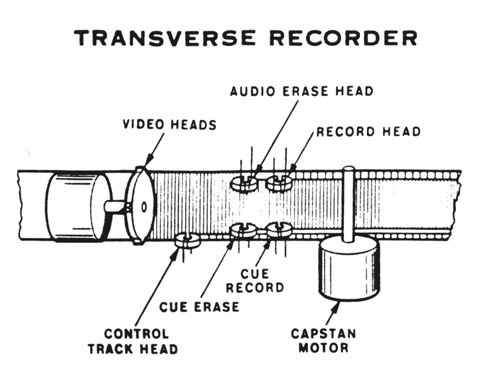
Thus, the heads leave on the tape a series of transverse parallel lines with a signal in frequency modulation. So you can use almost the entire width, leaving a little space on the sides for supporting information. As a result, the tape can be skipped with adequate speed, and the heads move fast enough to record information.
To play from the film you need synchronization, the labels of which are written on the same tape with ordinary, non-rotating heads. Ordinary heads write audio track. In practice, the recording was carried out on a two-inch (50.8 mm) Quadruplex format tape (Quadruplex). As the name implies, four heads were placed on a rotating drum. The drum rotated at a speed of 14,440 (NTSC) or 15,000 (PAL) revolutions per minute. On one reel fit 90 minutes of video.
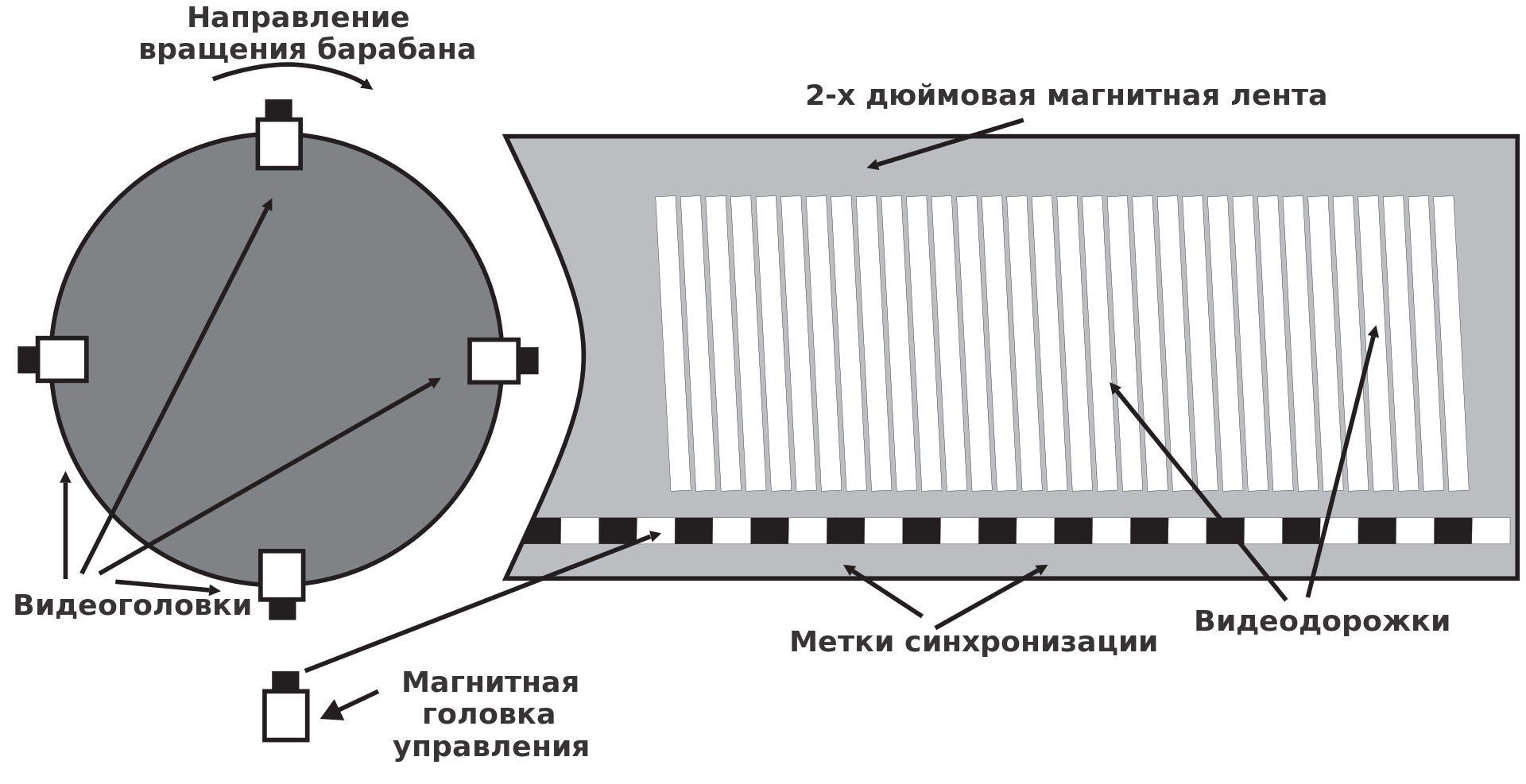
A similar recording technology was invented at a relatively small at the time of the American company Ampex, founded by an emigrant of Russian origin, Alexander Matveyevich Poniatov. The VRX-1000 was the first commercially successful video recorder. Its development began in October 1951, and the finished version was introduced only in 1956.

One of the first demonstration looked like a record of all those present on the film for about two minutes, rewind and display on the TV screen pictures. There was absolute silence during the playback, then a storm of applause began.
The VRX-1000 Mark IV cost $ 50,000 (about $ 450,000 today), each reel of Ampex-developed Quadruplex format cost $ 300 (≈ $ 2,700 in 2016). In this case, the film was erased after 30 uses. Obviously, the first buyers were large television studios.
Line tilt
The cross-line video had serious flaws. For example, it was impossible to play video in slow motion or make a still image. Each of the video tracks was only a part of the picture. For NSTC, each frame required 16 tracks, for PAL - 20. Only when playing at normal speed a distinct picture was obtained. By the way, if the four heads on the drum had the slightest difference, they appeared in the picture. The installation of the Q standard caused difficulties: precise synchronization was needed. The tape was mounted in the same way as an ordinary film: it was cut and glued. Only later appeared special devices for installation.
Educational film “BBC” about video editing on a tape recorder with a two-inch tape.
Slope systems were devoid of these problems. As the name implies, in them a rotating drum with heads forms lines on the tape at an angle. If you wrap the rotating drum almost completely, the long line will hold the whole frame. When you stop the movement of the tape, it will continue to read, giving the effect of a freeze frame. If you scroll forward or backward, the picture will also appear on the screen.
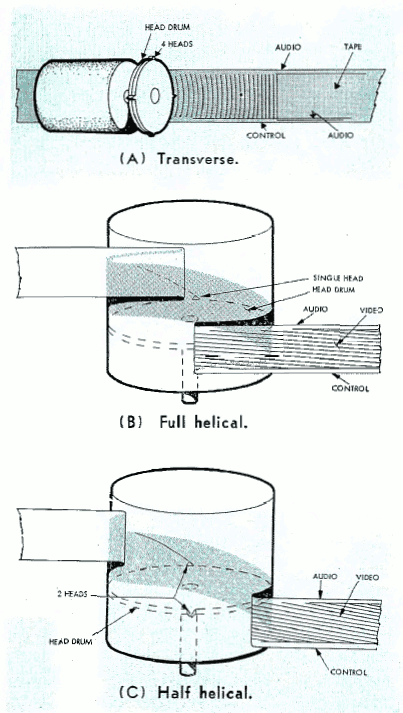
Comparison of systems with cross-lowercase and oblique-lowercase recording.
The same effect can be achieved if only half of the drum is wrapped with a tape, but using two heads - still one turn of the drum will mean reading or writing one frame. In the future, the number of heads only increased to add high-quality sound or to reduce the size of the drum.
Sony BVH-500 portable video recorder for 1-inch wide C tape and its normal operating noise with the lid open. In the lower left corner there is a large drum with reading heads.
And this recording method had its own problems. The magnetic tape is sometimes slightly stretched, the speed of rotation of individual elements varies, the angle of the drum operation relative to the tape tracks changes, and sometimes the tape recorder starts to chew the tape at all. Tape recorders demanded high precision performance and, in demanding situations, duplication.
Household accessibility
To contact video heads with a two-inch tape in a cross-line recording device, you need a vacuum clamp, and gas bearings require a compressor. Imagine a huge noisy installation in the life of an ordinary person is difficult. Therefore, for household video recorders used only oblique-line recording.
Ampex VR-2000. Color support and rewind by recording video on a special HS-100 hard disk weighing 2.3 kg at a speed of 60 (NTSC) or 50 (PAL) revolutions per minute. You could record 30 (installation for NTSC) or 36 (for PAL) seconds of video onto the disc. Then the video could be played back at normal speed, in slow motion, or even stopped at all.
In addition to these problems, the average person would hardly want to mess with the magnetic tape. Therefore, it is not surprising that cassette systems have gained popularity, where, in normal operation, the user never touches the tape. The tape recorders themselves wrap the tape around the heads.
Sony CV-2000 half-inch tape, one of the first VCRs for home use. Noticeable is the difficulty caused by the handling of the tape.
In the seventies, an ordinary person for the first time could choose what he wanted to watch, and not be content to be available only in movies and on television. For the first time there were opportunities for unlicensed copying and recording shown on TV. The first formats of video cassettes appeared: a square VCR box inserted into the Philips N1500 and Cartrivision quickly passed away.
By the mid-seventies, JVC's Betamax and VHS format developed by Sony came to the fore. This was followed by an extensive format war, a competitive confrontation between two proprietary ways of recording video for the title of the conventional. Each cassette has its own advantages and disadvantages. Betamax gave a slightly better picture format, but on a regular TV the difference with VHS was hardly felt. On VHS, you could record much more video: 120, 240 minutes or even more against an hour or more with Betamax.
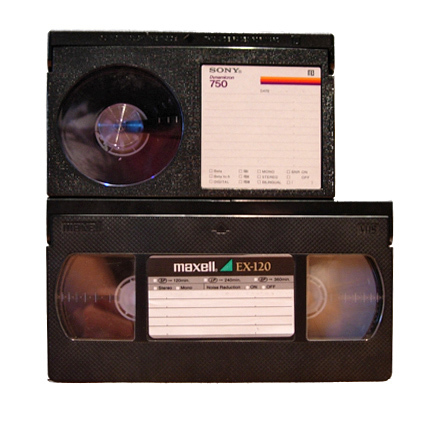
With all the advantages of Betamax, buyers were most often interested in accessibility. As a result, a large share of the market was received by that format, which at the time of release allowed recording almost any film, was supported by many producers under a license and was cheaper for its buyer. Betamax remained a niche product until the end of its existence. Prior to the two thousandth in the living room will edit videotape VHS.
Some of them fell behind the “iron curtain”. The order of the Soviet Union imposed many interesting restrictions on the lives of ordinary citizens. For example, access to document copiers was strictly limited . It is not surprising that initially the “video” was treated with wariness, turning into persecution.
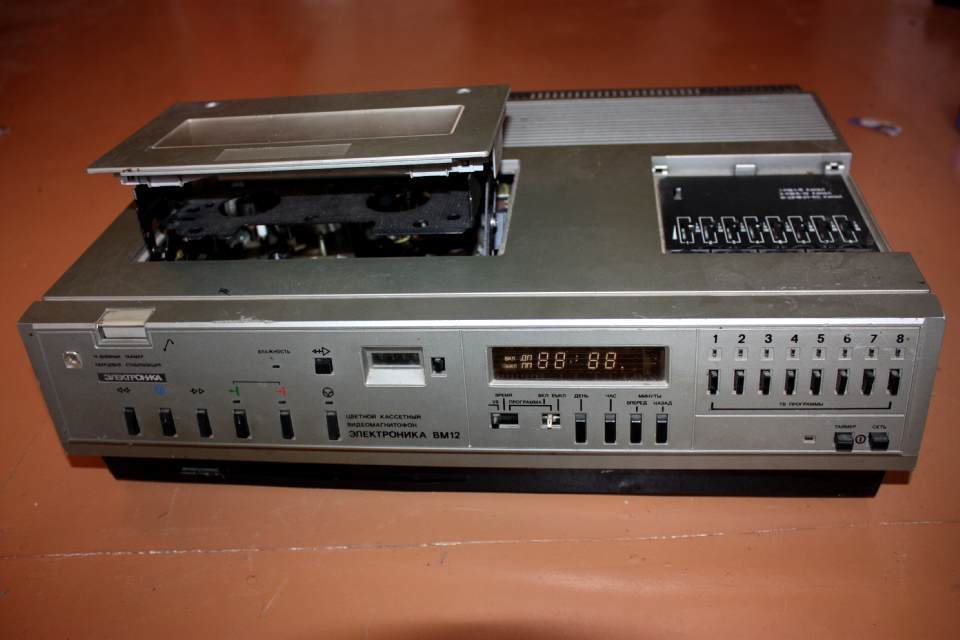
The VCR " Electronics VM-12 ", a symbol of the era, was produced from 1984 to 1995.
The massive hit in the country of VHS format video tapes left in the memories of the end of the eighties the aftertaste of the movie era in a pirate translation. It is unlikely that this would be possible if films in the West were distributed only on some uncopyable LaserDisc .
Fading away
From the mid-nineties, television studios began to leave the tape. Her place was taken by digital recording. Difficult video editing, the creation of special effects, rewriting without loss of quality - the tape could not provide all this. Older systems are incompatible with high definition television, which is now widely used today. Even the digital formats of the magnetic film and the standards of high-definition tapes did not help. Today professional videos are written and stored in digital form on solid-state drives, sometimes hard drives.
In everyday life, VCRs lasted several years longer. Audio tapes are gone under the onslaught of CD, video on magnetic tape has given way to DVD. Later, HD-DVD and Blu-ray began to fight for a place in the sun, each of which gave an even better picture. But this is a completely different format war. At that moment, the fate of bulky cassettes with a lot of fragile moving parts and a tape that needed to be rewound to achieve the right moment was of little interest to anyone. Cheap access to the network has led to the fact that the video is often no longer bought on the media and do not even download, and watch online on request.
Video tapes remained only in horror films - VHS is no longer released today. Not only the format dies, but also the entries on it - they live 10-20 years . The tape is demagnetized, the powder on it is decomposed, plastic cassettes are scattered.
According to LabGuy's World , h2g2 and AmericanHeritage.com .
Source: https://habr.com/ru/post/398329/
All Articles